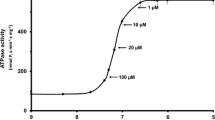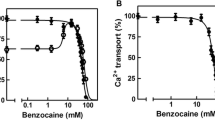Abstract
The ultrastructure of rabbit skeletal muscle was studied following glycerolation and staining with pyroantimonate. Electron-dense deposits were observed within the residual sarcoplasmic reticulum and associated with myofilaments. These dense granules were removed by chelation with EGTA and granules reappeared at these same sites upon the addition of calcium ions to the incubation medium. Specific inter- and intra-myofibrillar binding sites were thus confirmed. Myofilament binding sites were found to be a function of sarcomere length, since the granule distribution was different when shorter sarcomeres were compared to longer sarcomeres. It is proposed that calcium bound to myofilaments plays an essential role in contraction coupling and relaxation.
Résumé
L'ultrastructure du muscle squelettique de lapin est étudiée après traitement au glycérol et colgoration au pyroantimonate. Des dépôts denses aux électrons sont observés dans le reticulum sarcoplasmique restant. Ils sont associés aux myofilaments. Ces granules denses sont éliminés par chélation à l'EDTA et ces granules réapparaissent aux mêmes localisations après adjonction d'ions calcium au milieu d'incubation. L'existence de sites de liaisons spécifiques inter et intramyofibrillaires est ainsi confirmée. Les sites de liaison des myofilaments sont en rapport avec la longueur du sarcomère, étant donné que la localisation des granules est différente lorsque des sarcomères plus courts sont comparés à des sarcomères plus longs. Il semble que le calcium lié aux myofilaments joue un rôle essentiel au cours de la coordination et de la phase de repos de la contraction musculaire.
Zusammenfassung
Die Ultrastruktur des Skelettmuskels von Kaninchen wurde durch Einlegen in Glycerin und Färbung mit Pyroantimonat untersucht. Es wurden im residualen Sarkoplasma-Reticulum elektronendichte Ablagerungen beobachtet und mit Myofilamenten in Zusammenhang gebracht. Diese dichten Granula verschwanden durch Chelation mit EGTA, und neue Granula erschienen an denselben Stellen, wenn dem Inkubationsmedium Calciumionen beigegeben wurden. Auf diese Weise wurde das Auftreten spezifischer inter- und intramyofibrillärer Bindungsstellen bestätigt. Es wurde festgestellt, daß die Myofilament-Bindungsstellen von der Länge der Sarkomeren abhingen, denn die Verteilung der Granula war verschieden, wenn kürzere Sarkomeren mit längeren verglichen wurden. Es wird vorgeschlagen, daß das an Myofilamente gebundene Calcium eine wesentliche Rolle in der Kontraktion, der Verbinding und der Relaxation spielt.
Similar content being viewed by others
References
Barany, M., Finkelman, F., Therattil-Antony, T.: Studies on the bound calcium of actin. Arch. Biochem. Biophys.98, 28 (1962)
Chidsey, C. A., III: Calcium metabolism in the normal and failing heart. Hosp. Pract.7, 65 (1972)
Davies, R. E.: A molecular theory of muscle contraction: Calcium dependent contractions with hydrogen bond formation plus ATP-dependent extensions of part of the myosinactin crossbridges. Nature (Lond.)199, 1068 (1963)
Davis, Walter L.: Intracellular Ca++ binding sites in mammalian skeletal muscle: An electron microscopic study. Anat. Rec.169, 304 (1971)
Ebashi, S.: Calcium binding and relaxation in the actomyosin system. J. Biochem. (Tokyo)48, 150 (1960)
Ebashi, S.: Calcium binding activity of the vesicular relaxing factor. J. Biochem. (Tokyo)50, 236 (1961)
Ebashi, S.: Third component participating in the superprecipitation of ‘natural actomyosin’. Nature (Lond.)200, 1010 (1963)
Ebashi, S., Ebashi, F.: A new protein component participating in the superprecipitation of myosin B. J. Biochem. (Tokyo)55, 604 (1964)
Ebashi, S., Ebashi, F., Fujie, Y.: The effect of EDTA and its analogues on glycerinated muscle fibers and myosin adenosinetriphosphatase. J. Biochem. (Tokyo)47, 54 (1960)
Ebashi, S., Ebashi, F., Kodama, A.: Troponin as the Ca++-receptive protein in the contractile system. J. Biochem. (Tokyo)62, 137 (1967)
Ebashi, S., Endo, M.: Calcium ion and muscle contraction. Progr. Biophys. Molec. Biol.18, 123 (1968)
Ebashi, S., Kodama, A.: A new protein factor promoting aggregation of tropomyosin. J. Biochem. (Tokyo)58, 107 (1965)
Ebashi, S., Kodama, A.: Interaction of troponin with F-actin in the presence of tropomyosin. J. Biochem. (Tokyo)59, 425 (1966a)
Ebashi, S., Kodama, A.: Native tropomyosin-like action of troponin on trypsin treated myosin B. J. Biochem. (Tokyo)60, 733 (1966b)
Ebashi, S., Kodama, A., Ebashi, F.: Troponin: I. Preparation and physiologic function. J. Biochem. (Tokyo)64, 465 (1968)
Franzini-Armstrong, C.: Studies of the triad. II. Penetration of tracers into the junctional gap. J. Cell Biol.49, 196 (1971)
Fuchs, F., Briggs, F. N.: The site of calcium binding in relation to the activation of myofibrillar contraction. J. gen. Physiol.51, 655 (1968)
Hasselbach, W.: Die Bindung von Adenosindiphosphat, von anorganischem Phosphat und von Erdalkalien und die Strukturproteins des Muskels. Biochim. biophys. Acta (Amst.)25, 562 (1957)
Kitagawa, S., Yoshimura, J., Tonomura, Y.: On the active site of myosin A-adenosinetriphosphatase. II. Properties of the trinitrophenyl enzyme and the enzyme free from bivalent cations. J. biol. Chem.236, 902 (1961)
Komnick, H., Komnick, U.: Electronenmikroskopische Untersuchungen zur funktionellen Morphologie des Ionentransportes in der Saldrüse vonLarus argentatus. Z. Zellforsch.60, 163 (1963)
Legato, M. J., Langer, G. A.: The subcellular localization of calcium ion in mammalian myocardium. J. Cell Biol.41, 401 (1969)
Martin, J. H., Lynn, J. A., Nickey, W. M.: A rapid polychrome stain for epoxy embedded tissue. Amer. J. clin. Path.46, 25 (1966)
Ogawa, Y.: The apparent binding constant of glycoletherdiaminetetraacetic acid for calcium at neutral pH. J. Biochem. (Tokyo)64, 255 (1968)
Ohtsuki, I., Masaki, T., Nonomura, Y., Ebashi, S.: Periodic distribution of troponin along the thin filament. J. Biochem. (Tokyo)61, 817 (1967)
Parker, C. J., Gergely, J.: The role of calcium in the adenosine triphosphastase activity of myofibrils and in the mechanism of the relaxing factor system of muscle. J. biol. Chem.236, 411 (1961)
Tandler, C. J., Libanati, C., Sanchis, C. A.: The intracellular localization of inorganic cations with potassium pyroantimonate: Electron microscopic and microprobe analysis. J. Cell Biol.45, 355 (1970)
Thomas, R. S., Greenawalt, J. W.: Microincineration, electron microscopy and electron diffraction of calcium phosphate loaded mitochondria. J. Cell Biol.39, 55 (1968)
Winegrad, S.: Autoradiographic studies of intracellular calcium in skeletal muscle. J. gen. Physiol.48, 455 (1965a)
Winegrad, S.: The location of muscle calcium with respect to the myofibrils. J. gen. Physiol.48, 997 (1965b)
Winegrad, S.: Role of intracellular calcium movements in excitation-contraction coupling in skeletal muscle. Fed. Proc.24, 1146 (1965c)
Yarom, R., Meiri, U.: Ultrastructural cation precipitation in frog skeletal muscle. I. Localization of pyroantimonate precipitate at rest and in tetanus. J. Ultrastruct. Res.34, 430 (1972)
Author information
Authors and Affiliations
Additional information
This work was supported in part by grants from the National Institutes of Health, Numbers DE0024-04, AM13799-01, and grant from the Atomic Energy Commission, AT-(40-1)-4056.
Rights and permissions
About this article
Cite this article
Davis, W.L., Matthews, J.L. & Martin, J.H. An electron microscopic study of myofilament calcium binding sites in native, EGTA-chelated and calcium reloaded glycerolated mammalian skeletal muscle. Calc. Tis Res. 14, 139–152 (1974). https://doi.org/10.1007/BF02060290
Received:
Accepted:
Issue Date:
DOI: https://doi.org/10.1007/BF02060290




